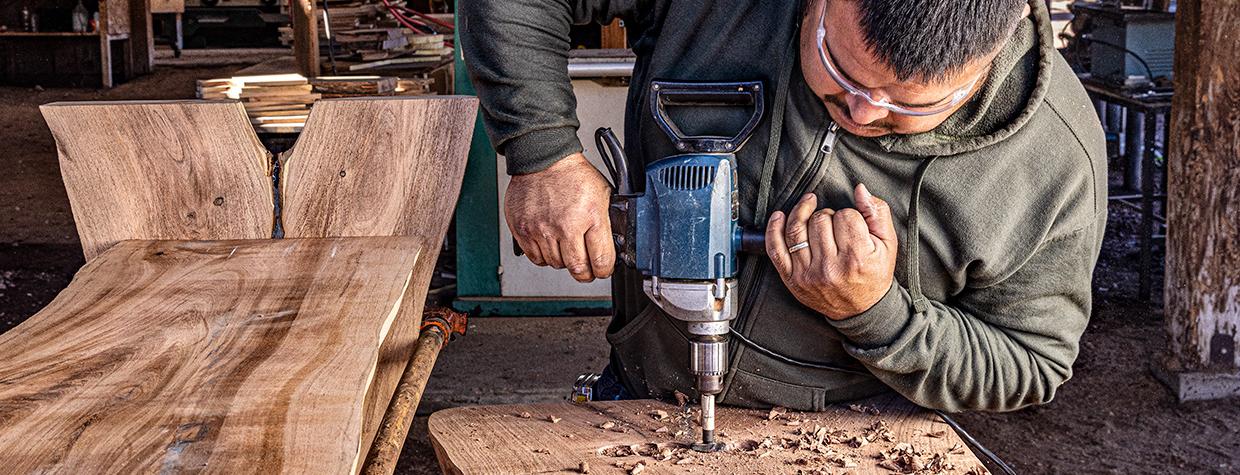What enigmatic inspiration or demon magic is it that lives in this tree — this arboreal delinquent, bristling with 2-inch thorns, that refuses to yield lumber that isn’t laced with crinkly crevices and bug labyrinths, that’s curdled with a history of animosity and chemical warfare against it?
How weird is its allure? Well, one dude with zero experience in woodworking bought a sawmill business dedicated solely to milling mesquite for furniture. Another, likewise inexperienced, built a sawmill for the same purpose. Decades later, both are still at it — crafting custom mesquite beds and tables and selling the crazed planks to other dreamers trying to tame it into civilized furniture.
Another mesquite enthusiast who started out making furniture is now distilling mesquite-smoked whiskey that a Forbes writer declared “might just be the most interesting spirit in the nation.” Another is selling mesquite-flour tortillas at farmers markets. Mesquite-grilled steak has been a Southwestern staple for generations, but now, mesquite cooking fires are spreading to pizza ovens and taco trucks. You can dine on mesquite-grilled lobster and ahi at a fancy Tucson resort. And for $250, you can book a night in a professionally built, 700-square-foot mesquite treehouse at the historic Shankle Ranch, 40 miles south of Tucson.
Is this just so much hype to play the tourists? Some is, sure — the slightly sweet, peppery flavoring of mesquite smoke is a very faint insinuation in that charred pizza crust. But the mesquite tree is nothing if not versatile and prodigiously useful. Which we’ve known for a long time, but we’re finally returning to accommodation with it.
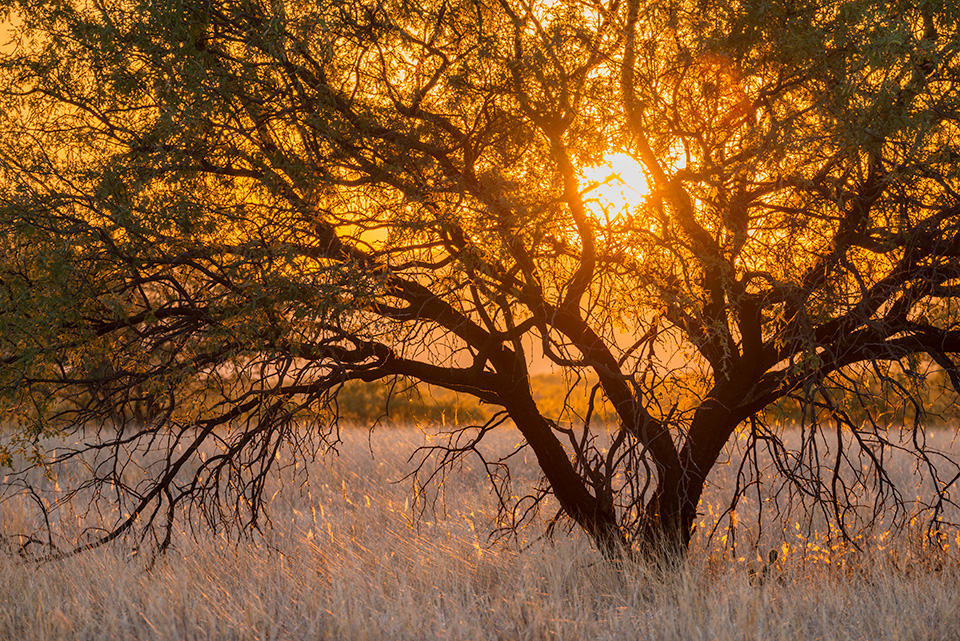
For at least a couple of millennia in the Tucson basin, the mesquite may have been the single most important plant in sustaining human life. The scraggly trees furnished ideal firewood for heating, cooking and firing pottery. Mesquite is hard and dense, so it burns hot and long. When the Hohokam people began building permanent settlements, mesquite trees furnished posts and beams for their pit houses — somewhat reluctantly, because a trunk or branch with a straight run of more than 6 feet is a rarity — and wattle for strengthening mud walls and roofs. The tree’s generous crop of seed pods, ground into flour, were the staple food source for early humans in the Sonoran Desert. “Over the decades, centuries and millennia,” writes ethnobotanist Gary Paul Nabhan, “they consistently provided more calories to the Indigenous inhabitants of the Tucson basin than corn had ever offered.”
Indirectly, mesquites also nourish the Sonoran Desert’s signature flora, saguaro cactuses — which themselves provide food in the form of ceremonial wine from the cactus’ fruit, pulped and fermented. Saguaros need partial shade for their first several years of life to avoid being broiled by the sun, and mesquites are among the prime nurse plants that provide it.
But when ranching arrived in Arizona in the 19th century, the long relationships between man and mesquite were splintered. Ranchers viewed the trees as unwelcome competitors for space and soil moisture on the grasslands that sustained their cattle. They declared war, furiously chopping, burning and poisoning. A 1952 U.S. Department of Agriculture booklet advised assaulting mesquite with sodium arsenite (a wide-spectrum soil sterilizer), kerosene and trichlorophenoxyacetic acid — all to less than no avail. As you can infer just by looking at it, mesquite is prodigiously tough and hard to kill. It’s also opportunistic, eager to exploit any innovation in its environment. When the ranchers’ cattle and horses nibbled mesquite pods, they spread seeds far and wide, helpfully depositing them with pads of warm, moist fertilizer. Bottom line: Between 1850 and 1950, mesquite density increased across three-quarters of its range in the continental United States.
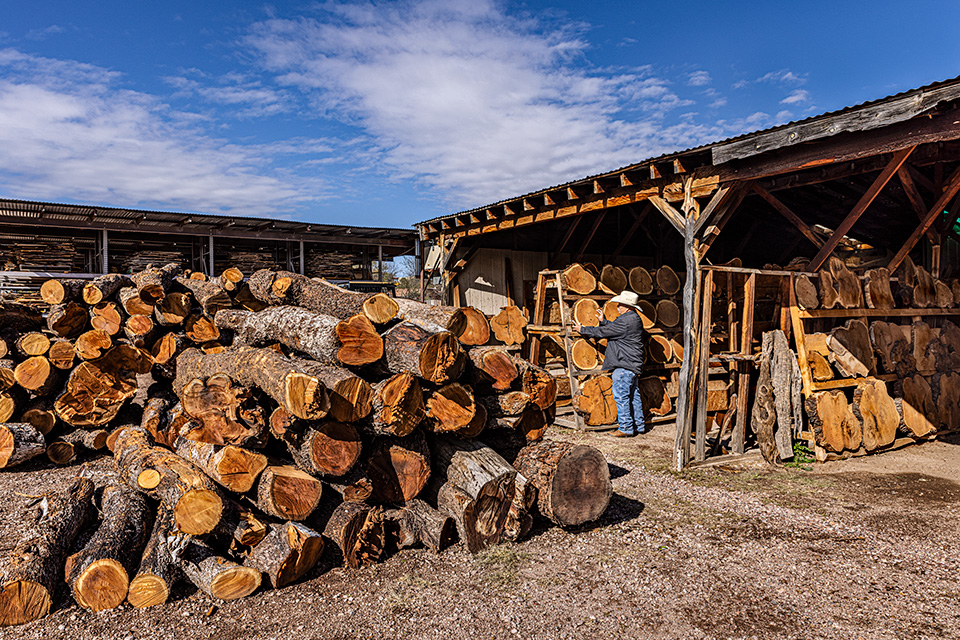
Tucson began appreciating mesquite earlier than most places in the Southwest. In 1928, as Phoenix was affirming its oasis personality with grass and regiments of palm trees, a developer planned Tucson’s quarter-square-mile Colonia Solana neighborhood around an existing arroyo and landscaped the open space entirely with native plants — including native mesquites that are grandly imposing today. (With adept pruning, a mature velvet mesquite tree can grow to 50 feet.) While Colonia Solana didn’t establish a universal standard for Tucson’s development, it did exert some influence, and at least since the 1970s, the urban landscape has gone increasingly native.
Of all the Sonoran Desert’s native trees, the mesquite is the most useful. Start with shade, which in the desert is best thought of as a spectrum, not an absolute. Desert people quickly learn that hardcore shadow isn’t necessarily the most comfortable refuge. It’s too dark, too extreme, its contrast with fierce sunlight almost painful. Mesquite leaves break and scatter the light into a filigree, rendering it not just harmless but attractive. You can lounge in a mesquite’s shade on a 90-degree afternoon and enjoy being outdoors. (Over 100 — well, no.) In Tucson, mesquites are at least as popular a landscaping staple as non-native shade trees are.
Over the past 20 years, mesquite flour seems to be showing up everywhere in Southern Arizona: bread, cookies, pancake mix, tortillas. There are milling fairs where people can bring buckets of dried pods and have them turned into flour. But this isn’t a miracle food — it’s work. Esperanza Arevalo, who’s been making mesquite tortillas since 2005, says she spent an entire year experimenting to perfect the blend of mesquite, amaranth and whole wheat flours — and it’s still finicky. “Even the weather is trouble,” she says. “If it’s too cold, the [flour] balls get sticky and won’t stretch out.”
It’s in furniture, though, that mesquite is enjoying the most dramatic renaissance.
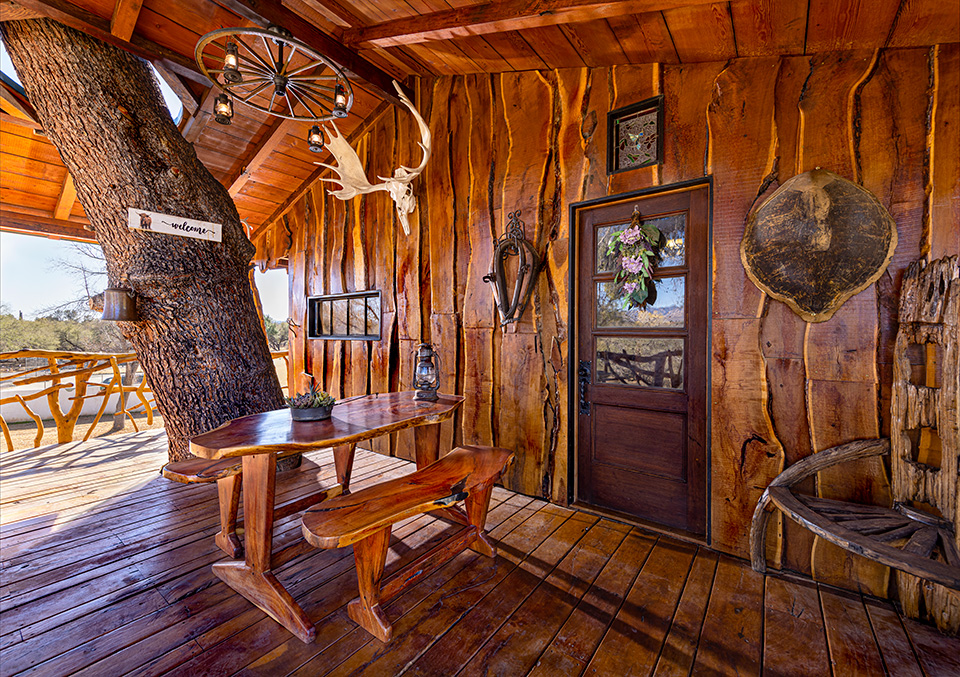
Art and Valerie Flores were coming off unrelated careers — his with Otis Elevator Co., hers in law enforcement — when in 2002 they stumbled across a small sawmill operation for sale near Tumacacori, a few miles north of the Mexican border. They bought it knowing absolutely nothing about milling or the wood the original proprietor was focusing on, which was mesquite. They were, and still are, fascinated by the wood and its possibilities. It’s not at all a cooperative wood, which we’ll get to in a moment. But at least there were a lot of sources for it. Harvesting a live mesquite in Arizona requires both permission from the landowner, whether private or government, and a permit from the Arizona Department of Agriculture. But monsoon storms occasionally blow trees down, and developers legally clear land for houses and golf courses. And 15 years ago, a U.S. Bureau of Land Management project to restore native grasslands near Sonoita yielded a stunning inventory, free to the Floreses for the taking. “We brought in about 2 million pounds,” Art recalls. They’re still working through it.
Mesquite is murder on sawmills. Not only is the wood extremely hard, it also harbors hidden nails, pebbles and even bullets that wreck blades. Wood-boring beetles import dirt and sand into their tunnels under the bark, and these foreign elements also grind down tools. “We’re lucky if we get four cuts before we have to sharpen a blade,” Art says.
Once cut, the raw planks need a lot of work before they become furniture. The beetle larvae must be disposed of, either by cutting off the outer sapwood or by kiln-drying, or else they could survive inside your dining table, patiently gnawing away. The wood is laced with holes and cracks, which have to be filled and sealed, usually with black-tinted epoxy. Every plank demands time-eating personal attention, so mass production is out of the question. A nearly finished dining table and chairs at the Floreses’ Tumacacori shop is going out for $19,000.
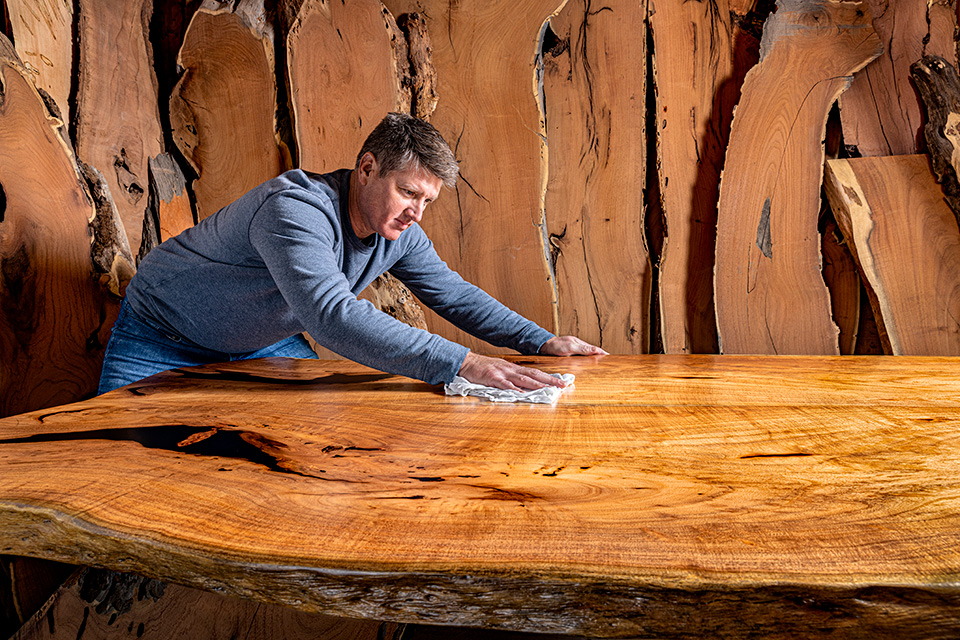
Mesquite has two qualities that make it worth the expense and trouble. The first is that if it’s been properly stabilized, it’s a phenomenally tough, durable wood, suitable for heirloom furnishings — it’s even harder to mar a mesquite table than it is to kill a mesquite tree. The second is its visual drama: It shows off a dramatic spectrum of color, ranging from a velvety beige through yellow to ruddy chocolate and finally charcoal black. Its grain reads like a topo map of an alien world, a geometric fandango of waves, swirls, switchbacks, whirlpools, fissures, caverns and eerily suggestive images. Valerie shows off a pair of book-matched planks on a cabinet where an unmistakable donkey’s face emerges from the grain. And she recalls the time in the sawmill’s furniture shop when craftsmen dry-fitted two book-matched panels and saw the devil glare at them from the wood. They stopped work on it.
Woodworker Tom Bonomi started Tucson’s Picture Rocks Mesquite in 2010 after building his own sawmill. He had no experience in woodworking, let alone sawmill engineering, but he remembered an uncle’s mesquite dining table he’d seen when he was 13 as “the most beautiful thing I’d ever seen.” He wanted to try building mesquite furniture but was discouraged by the retail cost of the wood. So, like Flores, he went into business both milling and crafting fine furniture.
Every furniture designer develops a personal style, although mesquite resists efforts to make it conform to a hard-edged and right-angled world. Bonomi favors the “live edge” style, with one or more edges left unfinished to follow the natural geography of the tree’s shape. No shape, in his thinking, is too wild to become domestic. Sometimes he’ll fill cracks with crushed turquoise, which contrasts dramatically with a black epoxy background and the earth tones of the surrounding grain. Flores produces live-edge pieces, but also squared-off cabinetry and furniture, for the nearby Tubac Golf Resort & Spa, where a mesquite theme has migrated even into the locker rooms and restrooms. “The partitions between the restroom stalls are mesquite,” Flores says. “I couldn’t believe they wanted us to do that.”
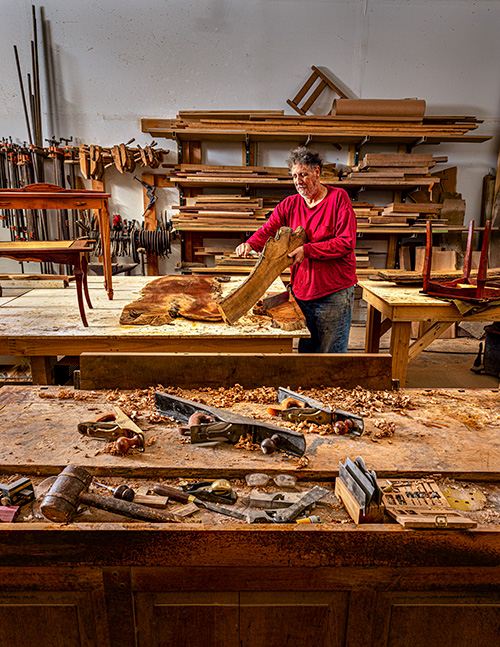
Dan Hostetler, another Tucson furniture builder, works with a variety of woods but says mesquite has grown to some 30 percent of his business in recent years. One of his most striking projects is a pair of rockers in the fluidly sculptural style popularized by famous woodworker Sam Maloof. It’s a rare example of a craftsman successfully forcing mesquite to become things it never dreamed of. “With mesquite, you’re never going to get grain to line up and match, so you might as well go for all the contrast you can get,” Hostetler says.
Beyond its surface beauty, what accounts for mesquite’s dramatic resurgence in utility? On some level, we’re attracted to its endurance and toughness, qualities we like to imagine for ourselves. Once established, a mesquite tree doesn’t need pampering — it’s very good at defending itself and living as long as 200 years, even in the Sonoran Desert’s tough neighborhoods. Beauty in nature is often fragile and
evanescent, but the mesquite illustrates that something fierce and determined can also be lovely.
There’s a useful lesson for humanity in the mesquite tree’s transformation from scorned public enemy to useful and cherished resource. The tree didn’t change, but we did — in our attitudes toward it.
Waging war on nature seldom works. Figuring out how we might gracefully coexist with a botanical mobster like mesquite, to everyone’s benefit, is the better way.

